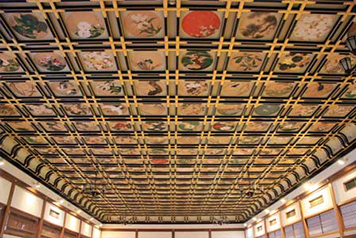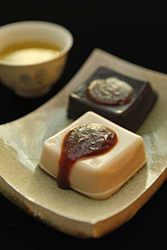Web Japan > Trends in Japan > Food & Travel > Fukui
Fukui
Ruminate About the Ancient Times in the “Dinosaur Kingdom”

Tojinbo’s precipitous cliffs are nearly 25 meters above sea level at the highest location. You can enjoy mother nature’s beautiful formations from various viewpoints on the walking trail along the rocky area, from the tower that looks down from 100 meters above sea level and by cruise boats that will guide you from the sea.
Blessed with the excellent fishing grounds of the Sea of Japan where both the warm and cold currents meet, Fukui has developed a rich food culture. Although seafood like Echizen crab, also known as the king of winter flavors, is plenty attractive, the dinosaur museum with its first class collection of artifacts is also gaining popularity. Fukui is full of highlights such as the earth’s naturally created beautiful formations, the numerous historical sites that tell us of the Japanese culture from hundreds of years ago as well as the colors that change along with Japan’s four seasons. To get to Fukui City, the starting point for many famous places, it will take about one hour by air from Haneda (Tokyo) to Komatsu Airport (Ishikawa Prefecture) where you will then take a bus from there for about another hour.
To “Earth, 120 Million Years Ago”
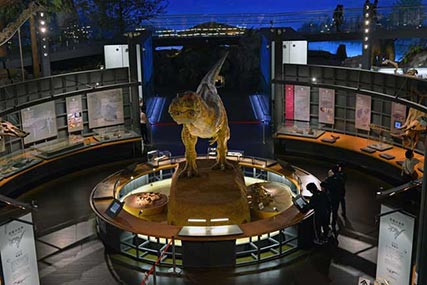
Katsuyama City’s Fukui Prefectural Dinosaur Museum, which is considered one of the world’s three great dinosaur museums alongside Canada and China, opened in 2000. With its numerous valuable specimens on exhibit including real dinosaur fossils, it is said that it is crowded with as many as 10,000 people in one day.
It takes a little more than one hour from Fukui City by local train. Katsuyama City, long known as a textile industry town for its traditional silk textiles etc., seems to be gaining attention in recent years as the location in Japan where the most dinosaur fossils have been discovered from the geological layer of 120 million years ago. As you look out from the bus window, there are giant dinosaur monuments placed in front of stations, street corners, and even in the countryside. As you gradually get more and more excited, a silver egg-like dome appears in the mountain valley. This is the Fukui Prefectural Dinosaur Museum, the base for dinosaur fossil excavations and a popular establishment with 500,000 people visiting every year.
The permanent collection exhibition room nearest to the entrance will first surprise you with its size at 4,500 square meters large. From the museum’s 40,000 artifacts, there are 1,800 items on display including 42 whole-body skeleton exhibits. You can enjoy looking at exhibits such as the moving dinosaur robot in the center, the Camarasaurus skeleton assembled with over 90% genuine fossils, and the giant dioramas recreated with life-size dinosaur models, from various viewpoints along the surrounding underground corridor. In summer 2014, hoping to create a new dinosaur boom, they plan to open a professional outdoor facility where you can gain excavation experience at an actual fossil excavation site.
Once you have fully immersed yourself into the atmosphere of ancient earth, one more place you will want to visit is Tojinbo, which is said to be Japan’s most unusual scenery. At these precipitous cliffs made from split volcanic rocks, in Sakai City at the prefectural border about 20 kilometers north of Fukui City, the dynamic scenery created by the raging waves of the Japan Sea crashing violently is a sight to be seen. The natural shape of these unusually shaped rocks are columnar joints of pyroxene andesite formed during the cooling and shrinking of underground magma that was erupted from the depths of earth 12 million years ago. This large range covering over one kilometer of these series of giant rocks that look like crystals of the earth, is a geologically valuable location as it can only be seen in three locations around the world along with Korea and Norway. Since there are no handrails or fences in order to preserve the landscape, it is quite thrilling to just stand on the cliff with the sea breeze blowing.
A Treasury of Seafood Including Crab and Blowfish
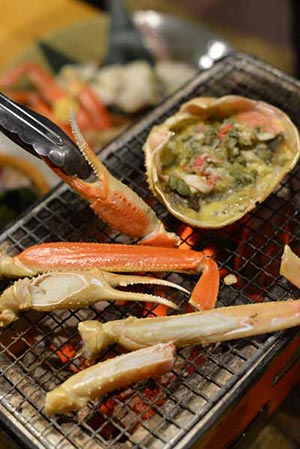
Enjoy the chewy meat of grilled crab that has been grilled whole over a charcoal fire. Mikuni Port’s Echizen crab is attractive with its freshness of being put on auction in the evening after a single day of fishing.
The joy of Fukui is not only the experience of encountering ancient earth. The Japan Sea, to which this area looks out on, is a treasury of seafood that would impress even a food connoisseur. Mikuni Port, which is next to Tojinbo, is Japan’s leading Echizen crab landing areas. Echizen crab, named after the region with its reputation for male Zuwai crabs, is a winter food that can only be tasted during the limited fishing season from November to March. Stuffing our mouths with its hot meat after being boiled whole is a standard eating style for this exceptionally fresh crab but it is also superb served grilled over a charcoal fire, as sashimi (sliced raw), or in nabe (hot pot) cooking.
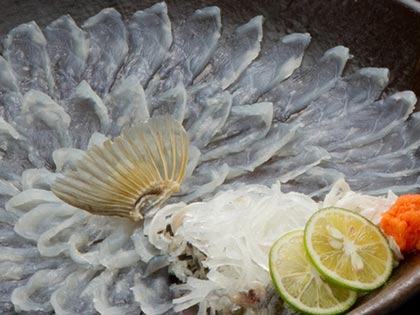
Blowfish sashimi (sliced raw fish) raised at Tsuruga Bay, known as Japan’s northernmost aquaculture production area. (Photo courtesy of qkamura echizenmikuni)

|
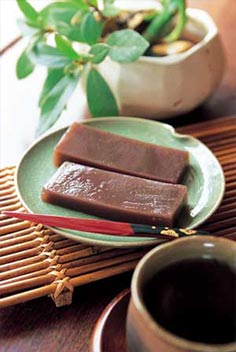
|
| Exactly 100 years have passed since the creation of the specialty dish sauce katsudon served with cutlets that are thinly sliced pork meat fried after being coated in fine bread crumbs and then drenched in a secret Worcestireshire sauce. (Courtesy of Yoroppaken) |
The nationwide summer sweet mizuyokan has become a winter sweet within Fukui Prefecture for some reason. © Fukui Tourist Association |
Alongside Echizen crab is Wakasa blowfish, also known as a Fukui brand product. They are raised in the Wakasa Bay of the southwestern part of Fukui prefecture. Tiger blowfish, raised in Japan’s northernmost aquaculture production area where winter water temperatures are cold, is characterized by its firmness, giving it its delicious taste.
Sauce katsudon is also highly popular as a local dish that can be eaten casually at many restaurants throughout the prefecture. These pork cutlets drenched in a special Worcestershire sauce and just served over a bowl of rice are prepared by being coated with fine bread crumbs so as not to soak up excess oil, giving them a nice crispy and chewy texture as well as being healthier than they look. Also, if in Fukui, it is customary in winter to eat mizuyokan, thick jellied Japanese sweet made of azuki bean paste, which is generally eaten in the summer. Tasting this cool Japanese sweet in a warm room with the heater running, you’ll want to enjoy its refined sweetness and the good feeling of it going down your throat.
A Program to Experience Zen Practice
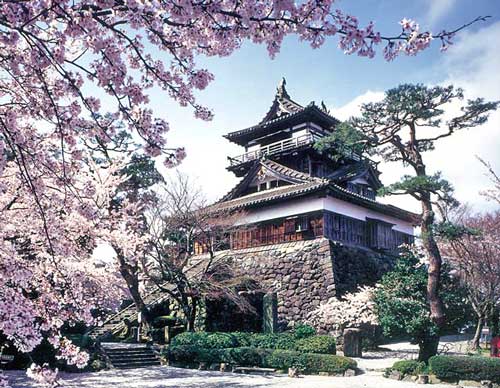
Maruoka Castle which passes down the oldest castle architectural style throughout Japan. It had collapsed due to an earthquake in 1948 but was rebuilt with all parts being reassembled. © Fukui Tourist Association
The time when Fukui (near Kyoto, once the capital of old Japan), which has come a long way in development from long ago, entered the center stage of history was during the 16th century when daimyo feudal lords struggled for supremacy in the war-torn country. In Sakai City, the Maruoka castle built in 1576, keeps its original appearance as it calmly overlooks the land just below. Of the 12 castle towers that exist in Japan, it is the oldest architectural style and uses a stone tiled roof that is extremely rare.
Eiheiji Temple (Eiheiji Town), 15 kilometers east of Fukui City, continues to teach Zen as the main temple of the Soto sect since 1244 when it opened. On the grounds surrounded by old Japanese cedar trees that are over 500 years old, there are over 70 historic buildings scattered, including the oldest main temple gate. In the tranquility, you can see about 180 monks in training as they devote themselves to their strict studies before your own eyes. For those who would like to, a system has been established where you can stay one to three nights to experience transcribing sutras and Zen meditation, live in the same lifestyle as the monk trainees and eat vegetarian dishes.
The diverse and profound traditional industries are still alive in Fukui Prefecture, which has a 1,500-year tradition of lacquer ware, and glasses that account for over 90% of the domestic products share. Echizen bamboo dolls, which have developed bamboo ware into a fine art, are also a traditional craft that flourished after it was originally started by making dolls from scrap wood during the winter. At the Echizen Bamboo Doll Village in Sakai City, the exhibition space that allows you to thoroughly appreciate the excellent pieces of art and the craftsmanship demonstrations are main attractions.
(February 2014)
- Sado (February 2012)




